Report: ABC Ltd's Singapore Expansion via Joint Venture Strategy
VerifiedAdded on 2020/04/21
|16
|3819
|43
Report
AI Summary
This report analyzes the expansion strategy of ABC Ltd, a technology company, into Singapore. It evaluates three legal relationship options: agency, distributor, and joint venture, highlighting their advantages and disadvantages. The report emphasizes Singapore's favorable business environment and recommends a joint venture as the optimal approach for long-term market entry. It details the key terms to be included in the joint venture agreement, such as head of terms, and the importance of protecting ABC Ltd's interests. The report underscores the benefits of a joint venture, including shared resources, risk mitigation, and access to local market expertise, ultimately positioning it as the most suitable option for ABC Ltd's sustainable growth in Singapore's technology-driven economy.

Paraphrase This Document
Need a fresh take? Get an instant paraphrase of this document with our AI Paraphraser
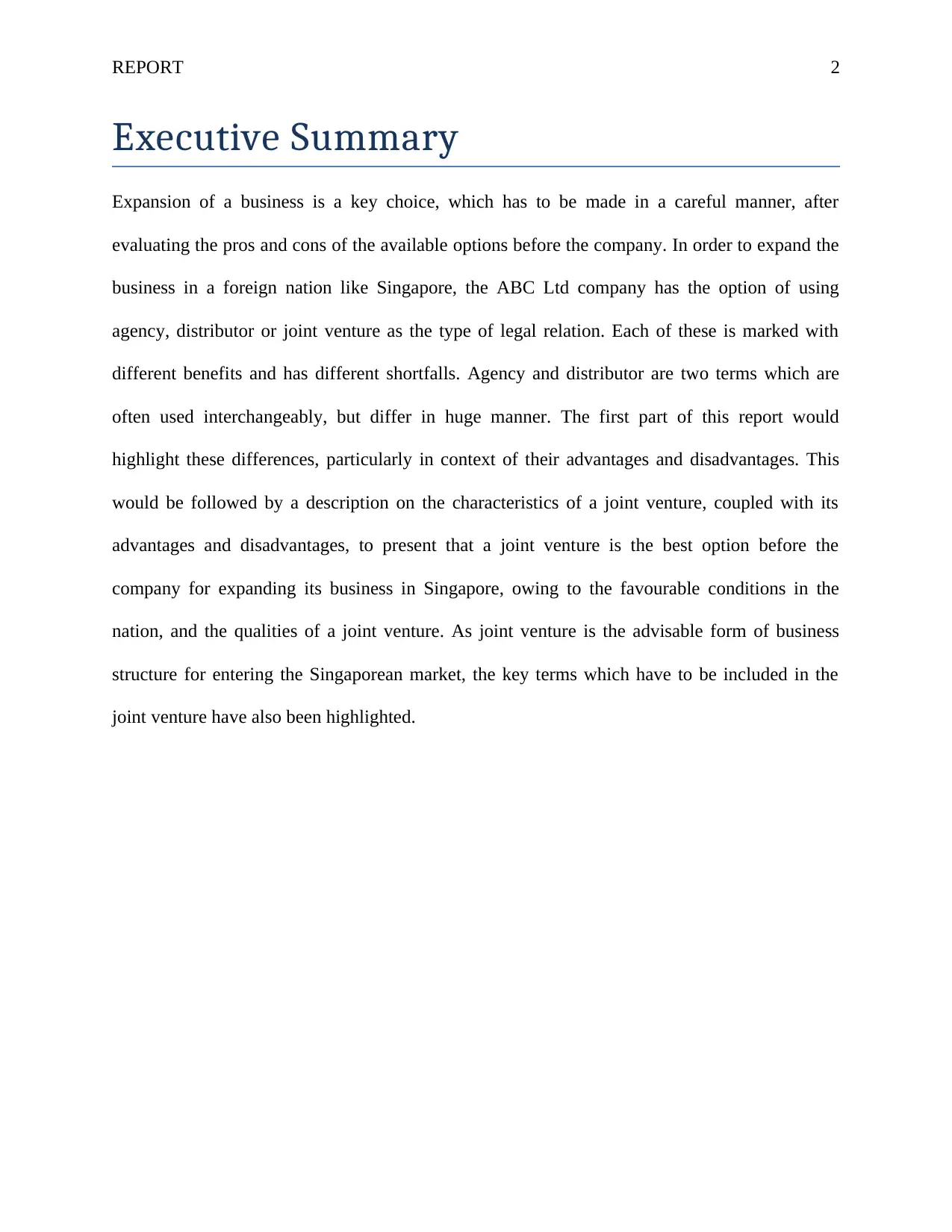
REPORT 2
Executive Summary
Expansion of a business is a key choice, which has to be made in a careful manner, after
evaluating the pros and cons of the available options before the company. In order to expand the
business in a foreign nation like Singapore, the ABC Ltd company has the option of using
agency, distributor or joint venture as the type of legal relation. Each of these is marked with
different benefits and has different shortfalls. Agency and distributor are two terms which are
often used interchangeably, but differ in huge manner. The first part of this report would
highlight these differences, particularly in context of their advantages and disadvantages. This
would be followed by a description on the characteristics of a joint venture, coupled with its
advantages and disadvantages, to present that a joint venture is the best option before the
company for expanding its business in Singapore, owing to the favourable conditions in the
nation, and the qualities of a joint venture. As joint venture is the advisable form of business
structure for entering the Singaporean market, the key terms which have to be included in the
joint venture have also been highlighted.
Executive Summary
Expansion of a business is a key choice, which has to be made in a careful manner, after
evaluating the pros and cons of the available options before the company. In order to expand the
business in a foreign nation like Singapore, the ABC Ltd company has the option of using
agency, distributor or joint venture as the type of legal relation. Each of these is marked with
different benefits and has different shortfalls. Agency and distributor are two terms which are
often used interchangeably, but differ in huge manner. The first part of this report would
highlight these differences, particularly in context of their advantages and disadvantages. This
would be followed by a description on the characteristics of a joint venture, coupled with its
advantages and disadvantages, to present that a joint venture is the best option before the
company for expanding its business in Singapore, owing to the favourable conditions in the
nation, and the qualities of a joint venture. As joint venture is the advisable form of business
structure for entering the Singaporean market, the key terms which have to be included in the
joint venture have also been highlighted.
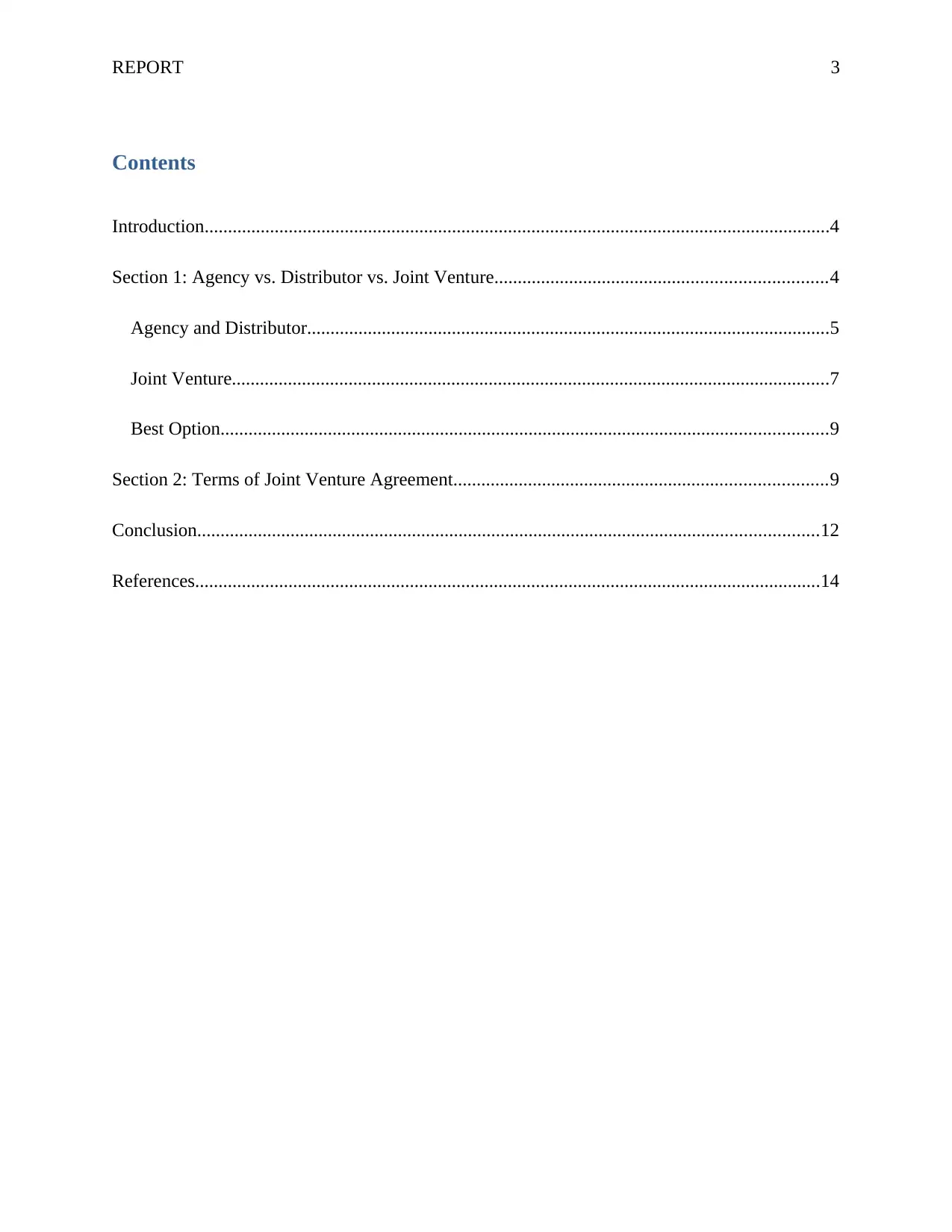
REPORT 3
Contents
Introduction......................................................................................................................................4
Section 1: Agency vs. Distributor vs. Joint Venture.......................................................................4
Agency and Distributor................................................................................................................5
Joint Venture................................................................................................................................7
Best Option..................................................................................................................................9
Section 2: Terms of Joint Venture Agreement................................................................................9
Conclusion.....................................................................................................................................12
References......................................................................................................................................14
Contents
Introduction......................................................................................................................................4
Section 1: Agency vs. Distributor vs. Joint Venture.......................................................................4
Agency and Distributor................................................................................................................5
Joint Venture................................................................................................................................7
Best Option..................................................................................................................................9
Section 2: Terms of Joint Venture Agreement................................................................................9
Conclusion.....................................................................................................................................12
References......................................................................................................................................14
⊘ This is a preview!⊘
Do you want full access?
Subscribe today to unlock all pages.

Trusted by 1+ million students worldwide
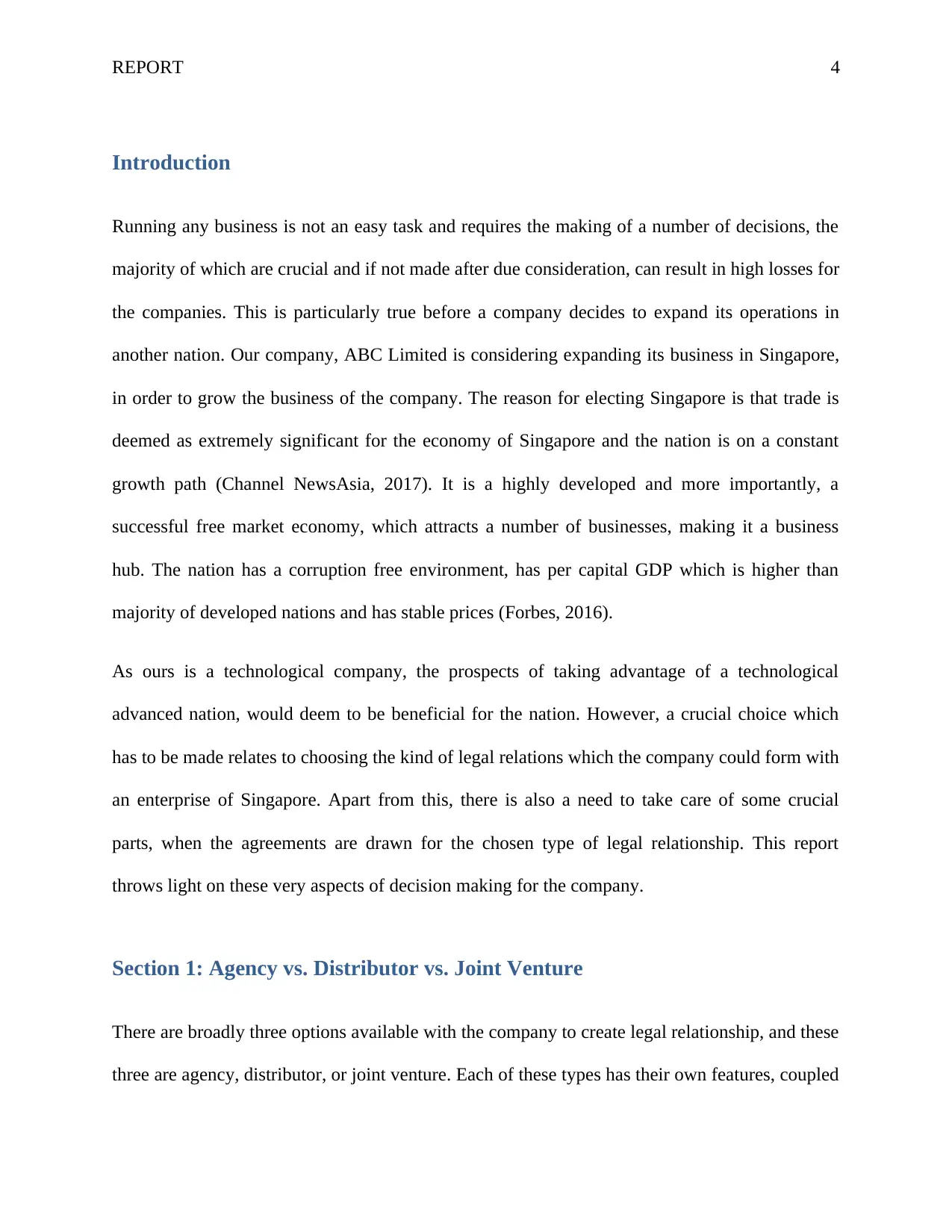
REPORT 4
Introduction
Running any business is not an easy task and requires the making of a number of decisions, the
majority of which are crucial and if not made after due consideration, can result in high losses for
the companies. This is particularly true before a company decides to expand its operations in
another nation. Our company, ABC Limited is considering expanding its business in Singapore,
in order to grow the business of the company. The reason for electing Singapore is that trade is
deemed as extremely significant for the economy of Singapore and the nation is on a constant
growth path (Channel NewsAsia, 2017). It is a highly developed and more importantly, a
successful free market economy, which attracts a number of businesses, making it a business
hub. The nation has a corruption free environment, has per capital GDP which is higher than
majority of developed nations and has stable prices (Forbes, 2016).
As ours is a technological company, the prospects of taking advantage of a technological
advanced nation, would deem to be beneficial for the nation. However, a crucial choice which
has to be made relates to choosing the kind of legal relations which the company could form with
an enterprise of Singapore. Apart from this, there is also a need to take care of some crucial
parts, when the agreements are drawn for the chosen type of legal relationship. This report
throws light on these very aspects of decision making for the company.
Section 1: Agency vs. Distributor vs. Joint Venture
There are broadly three options available with the company to create legal relationship, and these
three are agency, distributor, or joint venture. Each of these types has their own features, coupled
Introduction
Running any business is not an easy task and requires the making of a number of decisions, the
majority of which are crucial and if not made after due consideration, can result in high losses for
the companies. This is particularly true before a company decides to expand its operations in
another nation. Our company, ABC Limited is considering expanding its business in Singapore,
in order to grow the business of the company. The reason for electing Singapore is that trade is
deemed as extremely significant for the economy of Singapore and the nation is on a constant
growth path (Channel NewsAsia, 2017). It is a highly developed and more importantly, a
successful free market economy, which attracts a number of businesses, making it a business
hub. The nation has a corruption free environment, has per capital GDP which is higher than
majority of developed nations and has stable prices (Forbes, 2016).
As ours is a technological company, the prospects of taking advantage of a technological
advanced nation, would deem to be beneficial for the nation. However, a crucial choice which
has to be made relates to choosing the kind of legal relations which the company could form with
an enterprise of Singapore. Apart from this, there is also a need to take care of some crucial
parts, when the agreements are drawn for the chosen type of legal relationship. This report
throws light on these very aspects of decision making for the company.
Section 1: Agency vs. Distributor vs. Joint Venture
There are broadly three options available with the company to create legal relationship, and these
three are agency, distributor, or joint venture. Each of these types has their own features, coupled
Paraphrase This Document
Need a fresh take? Get an instant paraphrase of this document with our AI Paraphraser
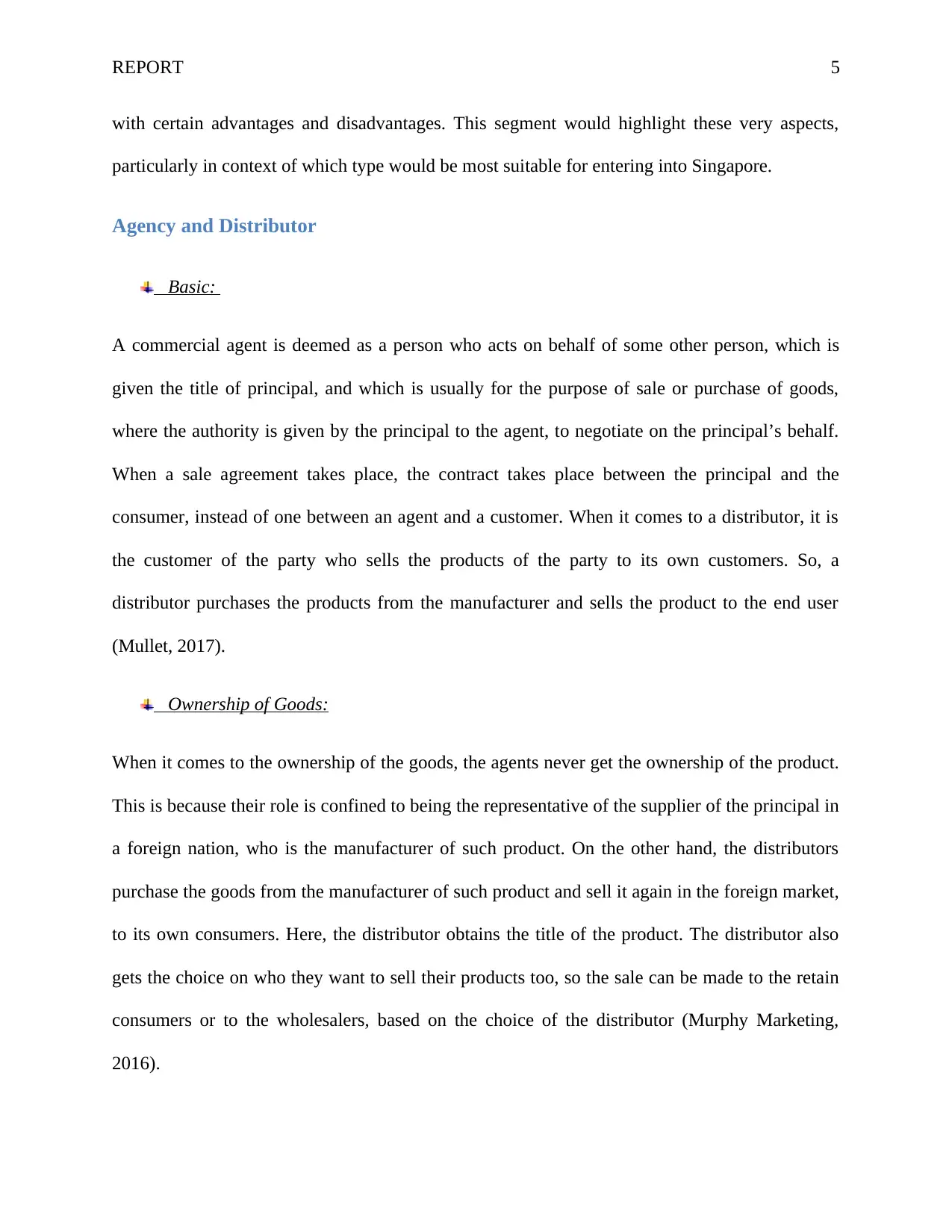
REPORT 5
with certain advantages and disadvantages. This segment would highlight these very aspects,
particularly in context of which type would be most suitable for entering into Singapore.
Agency and Distributor
Basic:
A commercial agent is deemed as a person who acts on behalf of some other person, which is
given the title of principal, and which is usually for the purpose of sale or purchase of goods,
where the authority is given by the principal to the agent, to negotiate on the principal’s behalf.
When a sale agreement takes place, the contract takes place between the principal and the
consumer, instead of one between an agent and a customer. When it comes to a distributor, it is
the customer of the party who sells the products of the party to its own customers. So, a
distributor purchases the products from the manufacturer and sells the product to the end user
(Mullet, 2017).
Ownership of Goods:
When it comes to the ownership of the goods, the agents never get the ownership of the product.
This is because their role is confined to being the representative of the supplier of the principal in
a foreign nation, who is the manufacturer of such product. On the other hand, the distributors
purchase the goods from the manufacturer of such product and sell it again in the foreign market,
to its own consumers. Here, the distributor obtains the title of the product. The distributor also
gets the choice on who they want to sell their products too, so the sale can be made to the retain
consumers or to the wholesalers, based on the choice of the distributor (Murphy Marketing,
2016).
with certain advantages and disadvantages. This segment would highlight these very aspects,
particularly in context of which type would be most suitable for entering into Singapore.
Agency and Distributor
Basic:
A commercial agent is deemed as a person who acts on behalf of some other person, which is
given the title of principal, and which is usually for the purpose of sale or purchase of goods,
where the authority is given by the principal to the agent, to negotiate on the principal’s behalf.
When a sale agreement takes place, the contract takes place between the principal and the
consumer, instead of one between an agent and a customer. When it comes to a distributor, it is
the customer of the party who sells the products of the party to its own customers. So, a
distributor purchases the products from the manufacturer and sells the product to the end user
(Mullet, 2017).
Ownership of Goods:
When it comes to the ownership of the goods, the agents never get the ownership of the product.
This is because their role is confined to being the representative of the supplier of the principal in
a foreign nation, who is the manufacturer of such product. On the other hand, the distributors
purchase the goods from the manufacturer of such product and sell it again in the foreign market,
to its own consumers. Here, the distributor obtains the title of the product. The distributor also
gets the choice on who they want to sell their products too, so the sale can be made to the retain
consumers or to the wholesalers, based on the choice of the distributor (Murphy Marketing,
2016).
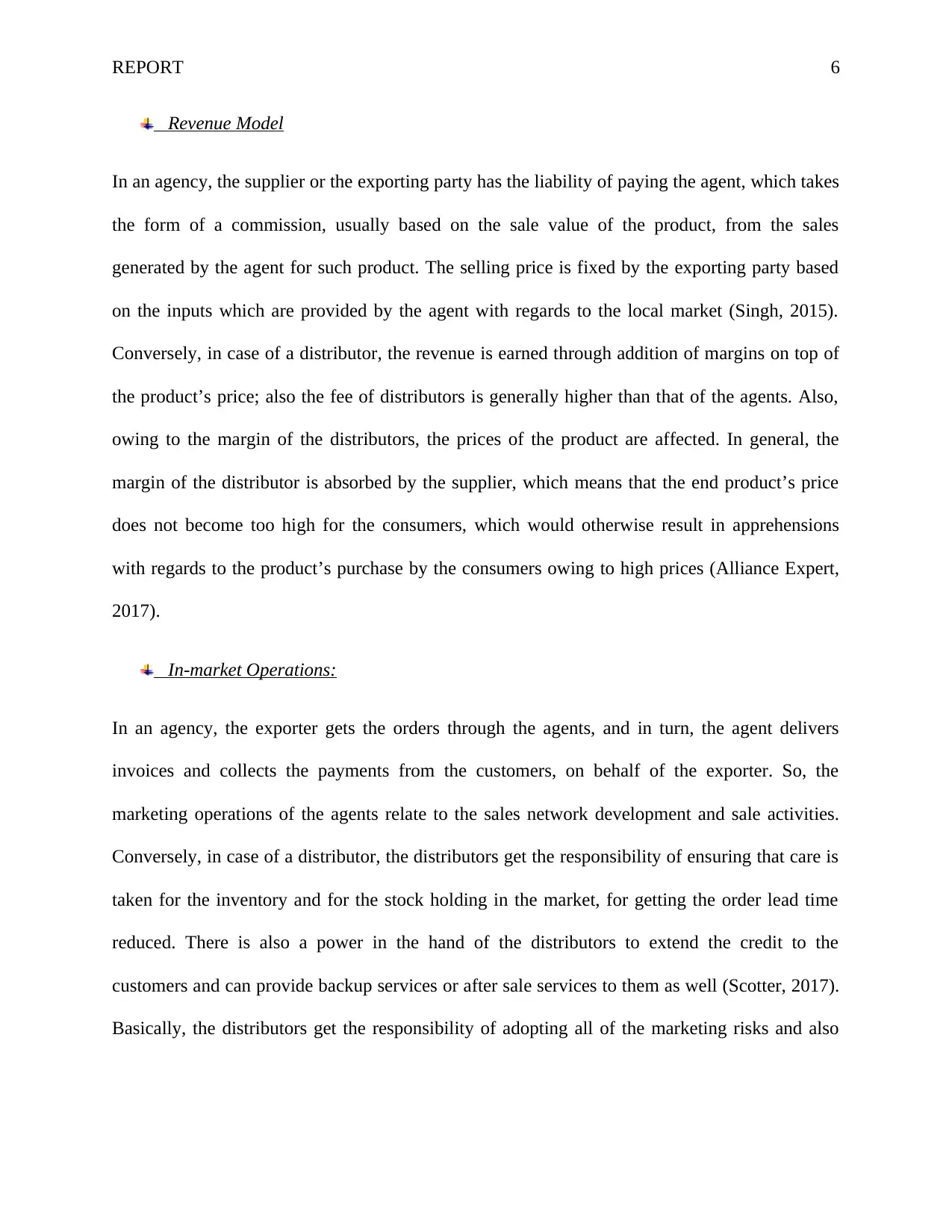
REPORT 6
Revenue Model
In an agency, the supplier or the exporting party has the liability of paying the agent, which takes
the form of a commission, usually based on the sale value of the product, from the sales
generated by the agent for such product. The selling price is fixed by the exporting party based
on the inputs which are provided by the agent with regards to the local market (Singh, 2015).
Conversely, in case of a distributor, the revenue is earned through addition of margins on top of
the product’s price; also the fee of distributors is generally higher than that of the agents. Also,
owing to the margin of the distributors, the prices of the product are affected. In general, the
margin of the distributor is absorbed by the supplier, which means that the end product’s price
does not become too high for the consumers, which would otherwise result in apprehensions
with regards to the product’s purchase by the consumers owing to high prices (Alliance Expert,
2017).
In-market Operations:
In an agency, the exporter gets the orders through the agents, and in turn, the agent delivers
invoices and collects the payments from the customers, on behalf of the exporter. So, the
marketing operations of the agents relate to the sales network development and sale activities.
Conversely, in case of a distributor, the distributors get the responsibility of ensuring that care is
taken for the inventory and for the stock holding in the market, for getting the order lead time
reduced. There is also a power in the hand of the distributors to extend the credit to the
customers and can provide backup services or after sale services to them as well (Scotter, 2017).
Basically, the distributors get the responsibility of adopting all of the marketing risks and also
Revenue Model
In an agency, the supplier or the exporting party has the liability of paying the agent, which takes
the form of a commission, usually based on the sale value of the product, from the sales
generated by the agent for such product. The selling price is fixed by the exporting party based
on the inputs which are provided by the agent with regards to the local market (Singh, 2015).
Conversely, in case of a distributor, the revenue is earned through addition of margins on top of
the product’s price; also the fee of distributors is generally higher than that of the agents. Also,
owing to the margin of the distributors, the prices of the product are affected. In general, the
margin of the distributor is absorbed by the supplier, which means that the end product’s price
does not become too high for the consumers, which would otherwise result in apprehensions
with regards to the product’s purchase by the consumers owing to high prices (Alliance Expert,
2017).
In-market Operations:
In an agency, the exporter gets the orders through the agents, and in turn, the agent delivers
invoices and collects the payments from the customers, on behalf of the exporter. So, the
marketing operations of the agents relate to the sales network development and sale activities.
Conversely, in case of a distributor, the distributors get the responsibility of ensuring that care is
taken for the inventory and for the stock holding in the market, for getting the order lead time
reduced. There is also a power in the hand of the distributors to extend the credit to the
customers and can provide backup services or after sale services to them as well (Scotter, 2017).
Basically, the distributors get the responsibility of adopting all of the marketing risks and also
⊘ This is a preview!⊘
Do you want full access?
Subscribe today to unlock all pages.

Trusted by 1+ million students worldwide
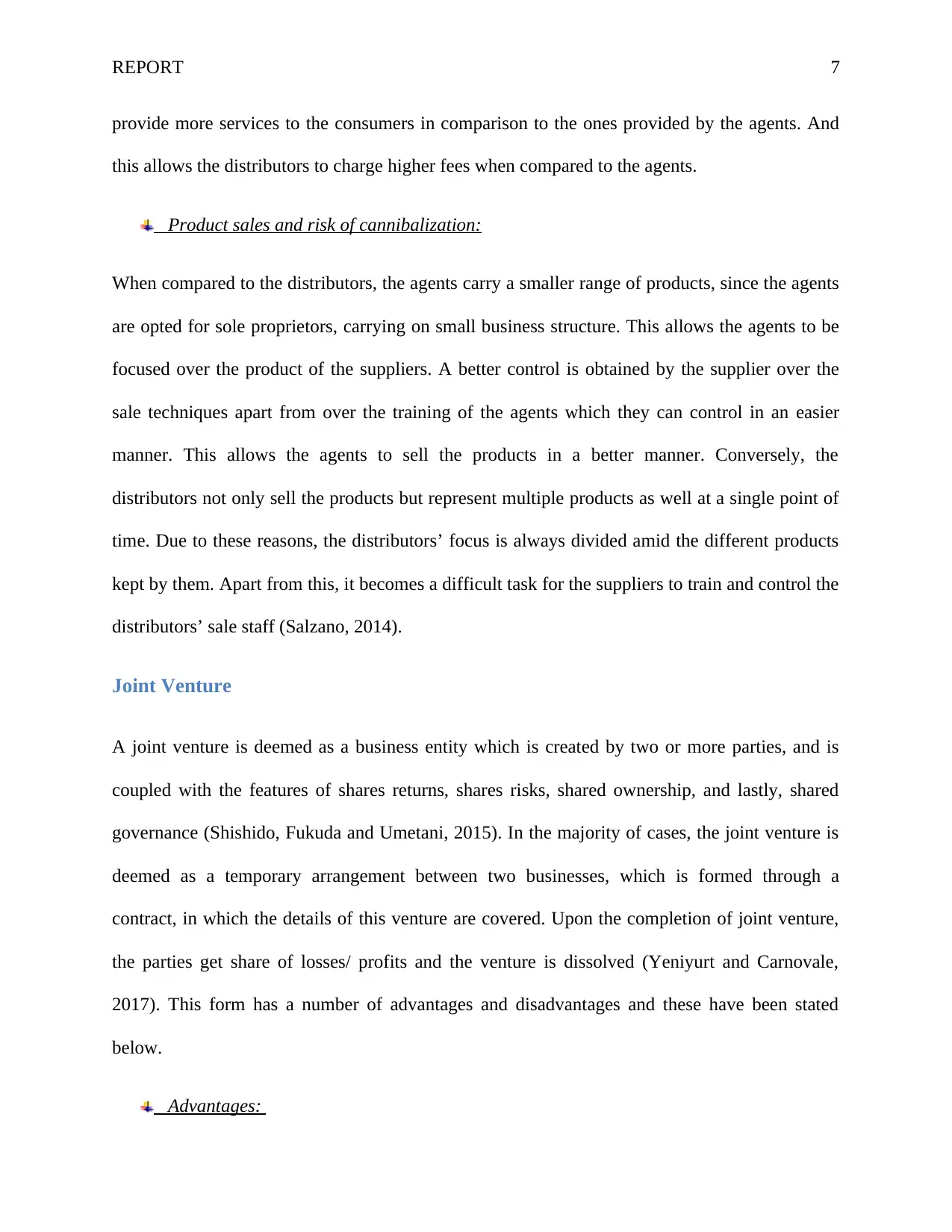
REPORT 7
provide more services to the consumers in comparison to the ones provided by the agents. And
this allows the distributors to charge higher fees when compared to the agents.
Product sales and risk of cannibalization:
When compared to the distributors, the agents carry a smaller range of products, since the agents
are opted for sole proprietors, carrying on small business structure. This allows the agents to be
focused over the product of the suppliers. A better control is obtained by the supplier over the
sale techniques apart from over the training of the agents which they can control in an easier
manner. This allows the agents to sell the products in a better manner. Conversely, the
distributors not only sell the products but represent multiple products as well at a single point of
time. Due to these reasons, the distributors’ focus is always divided amid the different products
kept by them. Apart from this, it becomes a difficult task for the suppliers to train and control the
distributors’ sale staff (Salzano, 2014).
Joint Venture
A joint venture is deemed as a business entity which is created by two or more parties, and is
coupled with the features of shares returns, shares risks, shared ownership, and lastly, shared
governance (Shishido, Fukuda and Umetani, 2015). In the majority of cases, the joint venture is
deemed as a temporary arrangement between two businesses, which is formed through a
contract, in which the details of this venture are covered. Upon the completion of joint venture,
the parties get share of losses/ profits and the venture is dissolved (Yeniyurt and Carnovale,
2017). This form has a number of advantages and disadvantages and these have been stated
below.
Advantages:
provide more services to the consumers in comparison to the ones provided by the agents. And
this allows the distributors to charge higher fees when compared to the agents.
Product sales and risk of cannibalization:
When compared to the distributors, the agents carry a smaller range of products, since the agents
are opted for sole proprietors, carrying on small business structure. This allows the agents to be
focused over the product of the suppliers. A better control is obtained by the supplier over the
sale techniques apart from over the training of the agents which they can control in an easier
manner. This allows the agents to sell the products in a better manner. Conversely, the
distributors not only sell the products but represent multiple products as well at a single point of
time. Due to these reasons, the distributors’ focus is always divided amid the different products
kept by them. Apart from this, it becomes a difficult task for the suppliers to train and control the
distributors’ sale staff (Salzano, 2014).
Joint Venture
A joint venture is deemed as a business entity which is created by two or more parties, and is
coupled with the features of shares returns, shares risks, shared ownership, and lastly, shared
governance (Shishido, Fukuda and Umetani, 2015). In the majority of cases, the joint venture is
deemed as a temporary arrangement between two businesses, which is formed through a
contract, in which the details of this venture are covered. Upon the completion of joint venture,
the parties get share of losses/ profits and the venture is dissolved (Yeniyurt and Carnovale,
2017). This form has a number of advantages and disadvantages and these have been stated
below.
Advantages:
Paraphrase This Document
Need a fresh take? Get an instant paraphrase of this document with our AI Paraphraser
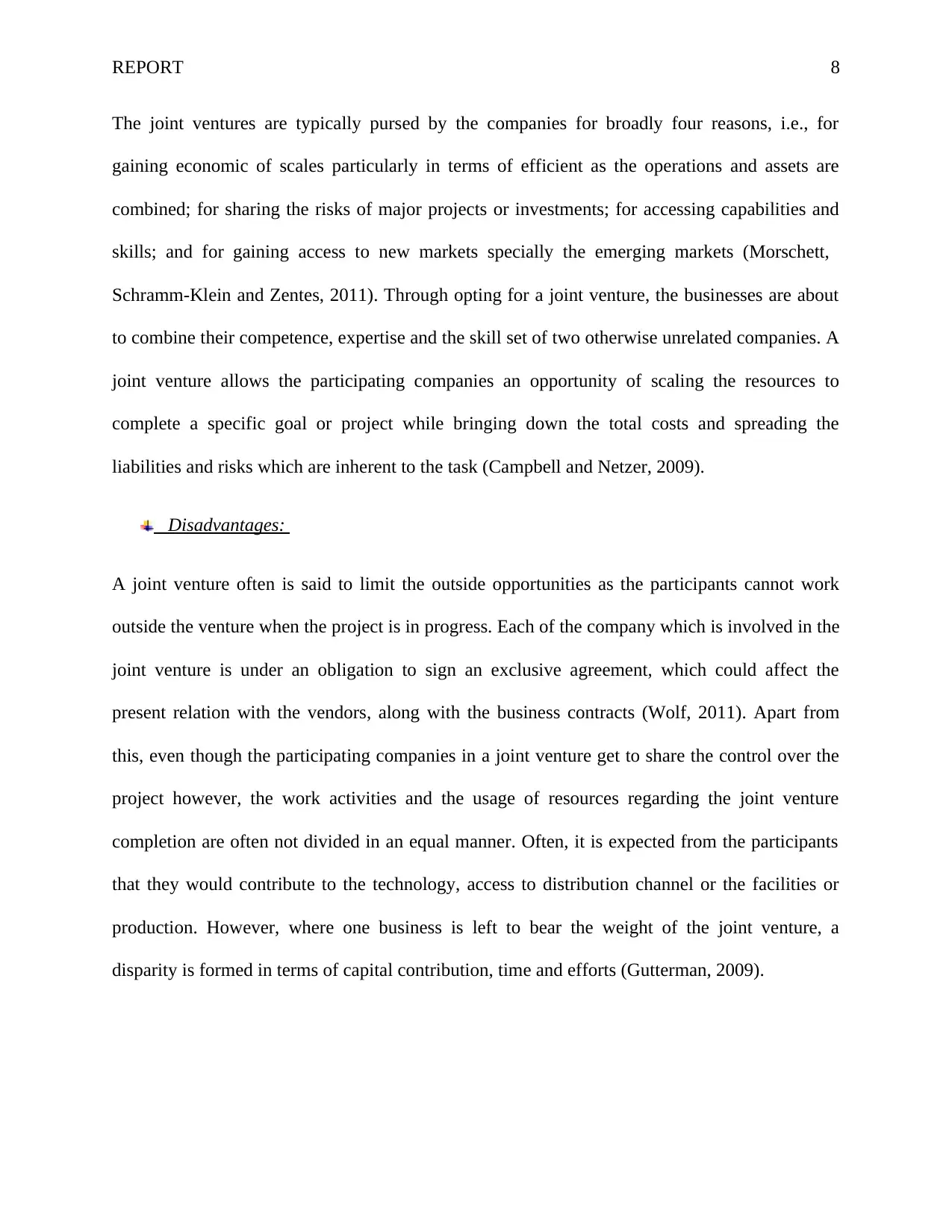
REPORT 8
The joint ventures are typically pursed by the companies for broadly four reasons, i.e., for
gaining economic of scales particularly in terms of efficient as the operations and assets are
combined; for sharing the risks of major projects or investments; for accessing capabilities and
skills; and for gaining access to new markets specially the emerging markets (Morschett,
Schramm-Klein and Zentes, 2011). Through opting for a joint venture, the businesses are about
to combine their competence, expertise and the skill set of two otherwise unrelated companies. A
joint venture allows the participating companies an opportunity of scaling the resources to
complete a specific goal or project while bringing down the total costs and spreading the
liabilities and risks which are inherent to the task (Campbell and Netzer, 2009).
Disadvantages:
A joint venture often is said to limit the outside opportunities as the participants cannot work
outside the venture when the project is in progress. Each of the company which is involved in the
joint venture is under an obligation to sign an exclusive agreement, which could affect the
present relation with the vendors, along with the business contracts (Wolf, 2011). Apart from
this, even though the participating companies in a joint venture get to share the control over the
project however, the work activities and the usage of resources regarding the joint venture
completion are often not divided in an equal manner. Often, it is expected from the participants
that they would contribute to the technology, access to distribution channel or the facilities or
production. However, where one business is left to bear the weight of the joint venture, a
disparity is formed in terms of capital contribution, time and efforts (Gutterman, 2009).
The joint ventures are typically pursed by the companies for broadly four reasons, i.e., for
gaining economic of scales particularly in terms of efficient as the operations and assets are
combined; for sharing the risks of major projects or investments; for accessing capabilities and
skills; and for gaining access to new markets specially the emerging markets (Morschett,
Schramm-Klein and Zentes, 2011). Through opting for a joint venture, the businesses are about
to combine their competence, expertise and the skill set of two otherwise unrelated companies. A
joint venture allows the participating companies an opportunity of scaling the resources to
complete a specific goal or project while bringing down the total costs and spreading the
liabilities and risks which are inherent to the task (Campbell and Netzer, 2009).
Disadvantages:
A joint venture often is said to limit the outside opportunities as the participants cannot work
outside the venture when the project is in progress. Each of the company which is involved in the
joint venture is under an obligation to sign an exclusive agreement, which could affect the
present relation with the vendors, along with the business contracts (Wolf, 2011). Apart from
this, even though the participating companies in a joint venture get to share the control over the
project however, the work activities and the usage of resources regarding the joint venture
completion are often not divided in an equal manner. Often, it is expected from the participants
that they would contribute to the technology, access to distribution channel or the facilities or
production. However, where one business is left to bear the weight of the joint venture, a
disparity is formed in terms of capital contribution, time and efforts (Gutterman, 2009).
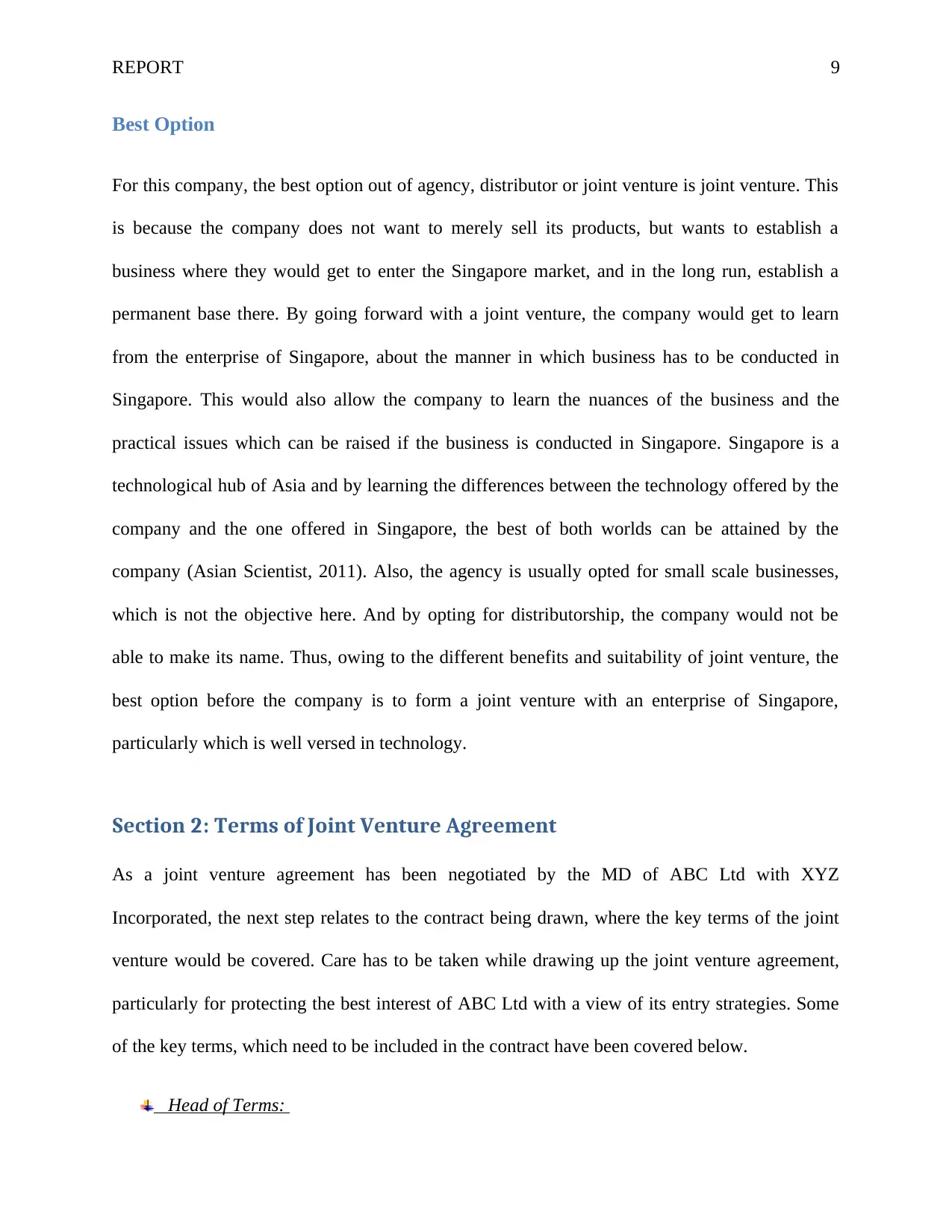
REPORT 9
Best Option
For this company, the best option out of agency, distributor or joint venture is joint venture. This
is because the company does not want to merely sell its products, but wants to establish a
business where they would get to enter the Singapore market, and in the long run, establish a
permanent base there. By going forward with a joint venture, the company would get to learn
from the enterprise of Singapore, about the manner in which business has to be conducted in
Singapore. This would also allow the company to learn the nuances of the business and the
practical issues which can be raised if the business is conducted in Singapore. Singapore is a
technological hub of Asia and by learning the differences between the technology offered by the
company and the one offered in Singapore, the best of both worlds can be attained by the
company (Asian Scientist, 2011). Also, the agency is usually opted for small scale businesses,
which is not the objective here. And by opting for distributorship, the company would not be
able to make its name. Thus, owing to the different benefits and suitability of joint venture, the
best option before the company is to form a joint venture with an enterprise of Singapore,
particularly which is well versed in technology.
Section 2: Terms of Joint Venture Agreement
As a joint venture agreement has been negotiated by the MD of ABC Ltd with XYZ
Incorporated, the next step relates to the contract being drawn, where the key terms of the joint
venture would be covered. Care has to be taken while drawing up the joint venture agreement,
particularly for protecting the best interest of ABC Ltd with a view of its entry strategies. Some
of the key terms, which need to be included in the contract have been covered below.
Head of Terms:
Best Option
For this company, the best option out of agency, distributor or joint venture is joint venture. This
is because the company does not want to merely sell its products, but wants to establish a
business where they would get to enter the Singapore market, and in the long run, establish a
permanent base there. By going forward with a joint venture, the company would get to learn
from the enterprise of Singapore, about the manner in which business has to be conducted in
Singapore. This would also allow the company to learn the nuances of the business and the
practical issues which can be raised if the business is conducted in Singapore. Singapore is a
technological hub of Asia and by learning the differences between the technology offered by the
company and the one offered in Singapore, the best of both worlds can be attained by the
company (Asian Scientist, 2011). Also, the agency is usually opted for small scale businesses,
which is not the objective here. And by opting for distributorship, the company would not be
able to make its name. Thus, owing to the different benefits and suitability of joint venture, the
best option before the company is to form a joint venture with an enterprise of Singapore,
particularly which is well versed in technology.
Section 2: Terms of Joint Venture Agreement
As a joint venture agreement has been negotiated by the MD of ABC Ltd with XYZ
Incorporated, the next step relates to the contract being drawn, where the key terms of the joint
venture would be covered. Care has to be taken while drawing up the joint venture agreement,
particularly for protecting the best interest of ABC Ltd with a view of its entry strategies. Some
of the key terms, which need to be included in the contract have been covered below.
Head of Terms:
⊘ This is a preview!⊘
Do you want full access?
Subscribe today to unlock all pages.

Trusted by 1+ million students worldwide
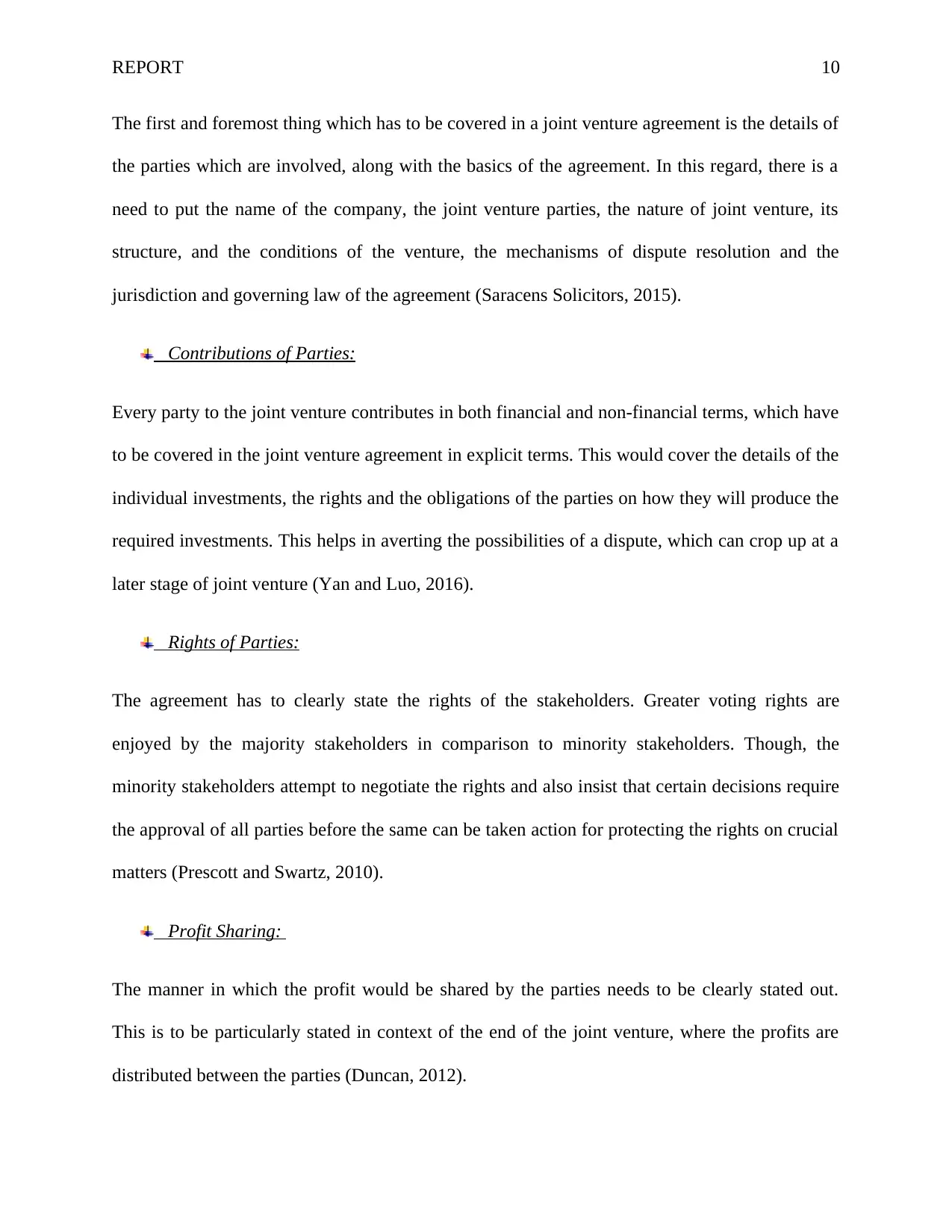
REPORT 10
The first and foremost thing which has to be covered in a joint venture agreement is the details of
the parties which are involved, along with the basics of the agreement. In this regard, there is a
need to put the name of the company, the joint venture parties, the nature of joint venture, its
structure, and the conditions of the venture, the mechanisms of dispute resolution and the
jurisdiction and governing law of the agreement (Saracens Solicitors, 2015).
Contributions of Parties:
Every party to the joint venture contributes in both financial and non-financial terms, which have
to be covered in the joint venture agreement in explicit terms. This would cover the details of the
individual investments, the rights and the obligations of the parties on how they will produce the
required investments. This helps in averting the possibilities of a dispute, which can crop up at a
later stage of joint venture (Yan and Luo, 2016).
Rights of Parties:
The agreement has to clearly state the rights of the stakeholders. Greater voting rights are
enjoyed by the majority stakeholders in comparison to minority stakeholders. Though, the
minority stakeholders attempt to negotiate the rights and also insist that certain decisions require
the approval of all parties before the same can be taken action for protecting the rights on crucial
matters (Prescott and Swartz, 2010).
Profit Sharing:
The manner in which the profit would be shared by the parties needs to be clearly stated out.
This is to be particularly stated in context of the end of the joint venture, where the profits are
distributed between the parties (Duncan, 2012).
The first and foremost thing which has to be covered in a joint venture agreement is the details of
the parties which are involved, along with the basics of the agreement. In this regard, there is a
need to put the name of the company, the joint venture parties, the nature of joint venture, its
structure, and the conditions of the venture, the mechanisms of dispute resolution and the
jurisdiction and governing law of the agreement (Saracens Solicitors, 2015).
Contributions of Parties:
Every party to the joint venture contributes in both financial and non-financial terms, which have
to be covered in the joint venture agreement in explicit terms. This would cover the details of the
individual investments, the rights and the obligations of the parties on how they will produce the
required investments. This helps in averting the possibilities of a dispute, which can crop up at a
later stage of joint venture (Yan and Luo, 2016).
Rights of Parties:
The agreement has to clearly state the rights of the stakeholders. Greater voting rights are
enjoyed by the majority stakeholders in comparison to minority stakeholders. Though, the
minority stakeholders attempt to negotiate the rights and also insist that certain decisions require
the approval of all parties before the same can be taken action for protecting the rights on crucial
matters (Prescott and Swartz, 2010).
Profit Sharing:
The manner in which the profit would be shared by the parties needs to be clearly stated out.
This is to be particularly stated in context of the end of the joint venture, where the profits are
distributed between the parties (Duncan, 2012).
Paraphrase This Document
Need a fresh take? Get an instant paraphrase of this document with our AI Paraphraser
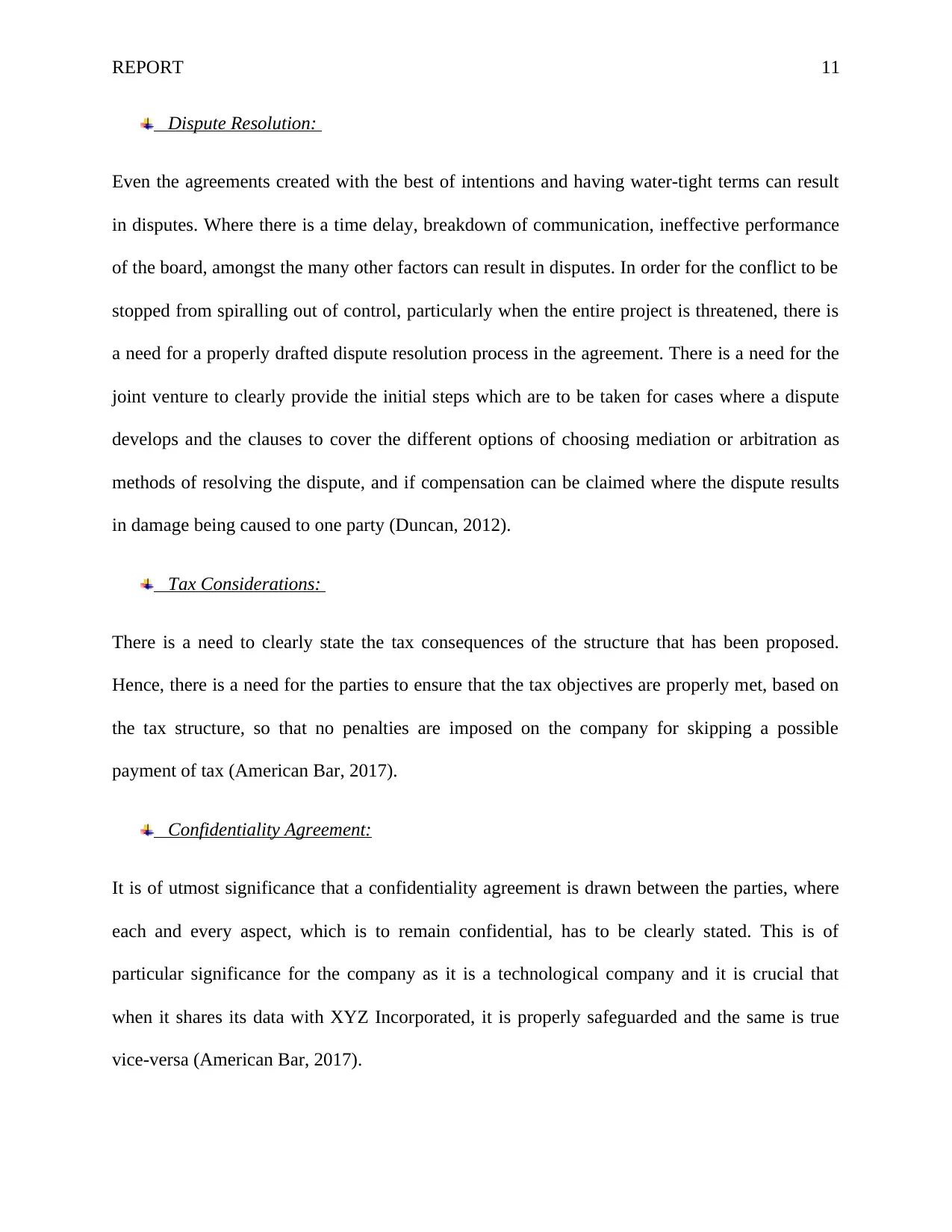
REPORT 11
Dispute Resolution:
Even the agreements created with the best of intentions and having water-tight terms can result
in disputes. Where there is a time delay, breakdown of communication, ineffective performance
of the board, amongst the many other factors can result in disputes. In order for the conflict to be
stopped from spiralling out of control, particularly when the entire project is threatened, there is
a need for a properly drafted dispute resolution process in the agreement. There is a need for the
joint venture to clearly provide the initial steps which are to be taken for cases where a dispute
develops and the clauses to cover the different options of choosing mediation or arbitration as
methods of resolving the dispute, and if compensation can be claimed where the dispute results
in damage being caused to one party (Duncan, 2012).
Tax Considerations:
There is a need to clearly state the tax consequences of the structure that has been proposed.
Hence, there is a need for the parties to ensure that the tax objectives are properly met, based on
the tax structure, so that no penalties are imposed on the company for skipping a possible
payment of tax (American Bar, 2017).
Confidentiality Agreement:
It is of utmost significance that a confidentiality agreement is drawn between the parties, where
each and every aspect, which is to remain confidential, has to be clearly stated. This is of
particular significance for the company as it is a technological company and it is crucial that
when it shares its data with XYZ Incorporated, it is properly safeguarded and the same is true
vice-versa (American Bar, 2017).
Dispute Resolution:
Even the agreements created with the best of intentions and having water-tight terms can result
in disputes. Where there is a time delay, breakdown of communication, ineffective performance
of the board, amongst the many other factors can result in disputes. In order for the conflict to be
stopped from spiralling out of control, particularly when the entire project is threatened, there is
a need for a properly drafted dispute resolution process in the agreement. There is a need for the
joint venture to clearly provide the initial steps which are to be taken for cases where a dispute
develops and the clauses to cover the different options of choosing mediation or arbitration as
methods of resolving the dispute, and if compensation can be claimed where the dispute results
in damage being caused to one party (Duncan, 2012).
Tax Considerations:
There is a need to clearly state the tax consequences of the structure that has been proposed.
Hence, there is a need for the parties to ensure that the tax objectives are properly met, based on
the tax structure, so that no penalties are imposed on the company for skipping a possible
payment of tax (American Bar, 2017).
Confidentiality Agreement:
It is of utmost significance that a confidentiality agreement is drawn between the parties, where
each and every aspect, which is to remain confidential, has to be clearly stated. This is of
particular significance for the company as it is a technological company and it is crucial that
when it shares its data with XYZ Incorporated, it is properly safeguarded and the same is true
vice-versa (American Bar, 2017).
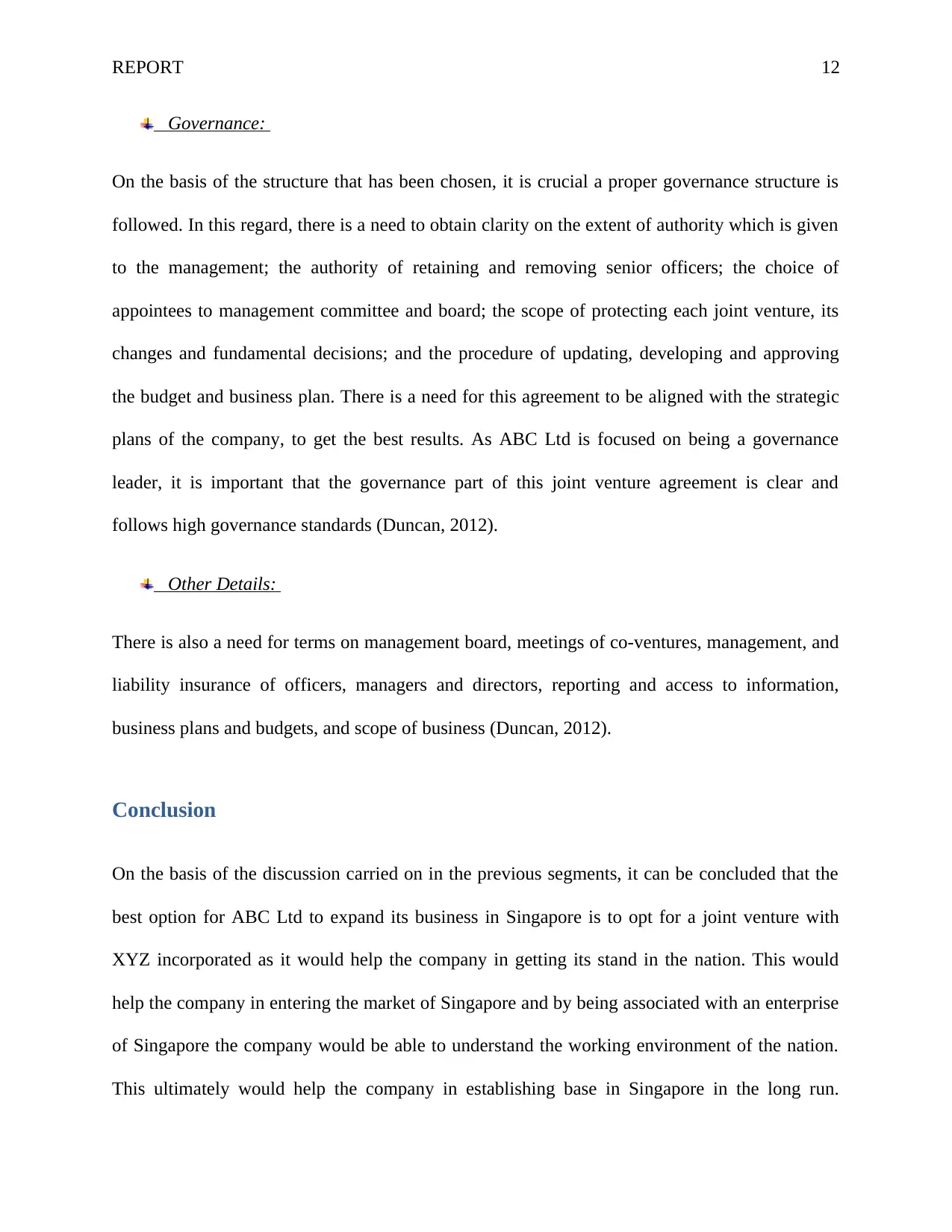
REPORT 12
Governance:
On the basis of the structure that has been chosen, it is crucial a proper governance structure is
followed. In this regard, there is a need to obtain clarity on the extent of authority which is given
to the management; the authority of retaining and removing senior officers; the choice of
appointees to management committee and board; the scope of protecting each joint venture, its
changes and fundamental decisions; and the procedure of updating, developing and approving
the budget and business plan. There is a need for this agreement to be aligned with the strategic
plans of the company, to get the best results. As ABC Ltd is focused on being a governance
leader, it is important that the governance part of this joint venture agreement is clear and
follows high governance standards (Duncan, 2012).
Other Details:
There is also a need for terms on management board, meetings of co-ventures, management, and
liability insurance of officers, managers and directors, reporting and access to information,
business plans and budgets, and scope of business (Duncan, 2012).
Conclusion
On the basis of the discussion carried on in the previous segments, it can be concluded that the
best option for ABC Ltd to expand its business in Singapore is to opt for a joint venture with
XYZ incorporated as it would help the company in getting its stand in the nation. This would
help the company in entering the market of Singapore and by being associated with an enterprise
of Singapore the company would be able to understand the working environment of the nation.
This ultimately would help the company in establishing base in Singapore in the long run.
Governance:
On the basis of the structure that has been chosen, it is crucial a proper governance structure is
followed. In this regard, there is a need to obtain clarity on the extent of authority which is given
to the management; the authority of retaining and removing senior officers; the choice of
appointees to management committee and board; the scope of protecting each joint venture, its
changes and fundamental decisions; and the procedure of updating, developing and approving
the budget and business plan. There is a need for this agreement to be aligned with the strategic
plans of the company, to get the best results. As ABC Ltd is focused on being a governance
leader, it is important that the governance part of this joint venture agreement is clear and
follows high governance standards (Duncan, 2012).
Other Details:
There is also a need for terms on management board, meetings of co-ventures, management, and
liability insurance of officers, managers and directors, reporting and access to information,
business plans and budgets, and scope of business (Duncan, 2012).
Conclusion
On the basis of the discussion carried on in the previous segments, it can be concluded that the
best option for ABC Ltd to expand its business in Singapore is to opt for a joint venture with
XYZ incorporated as it would help the company in getting its stand in the nation. This would
help the company in entering the market of Singapore and by being associated with an enterprise
of Singapore the company would be able to understand the working environment of the nation.
This ultimately would help the company in establishing base in Singapore in the long run.
⊘ This is a preview!⊘
Do you want full access?
Subscribe today to unlock all pages.

Trusted by 1+ million students worldwide
1 out of 16
Related Documents
Your All-in-One AI-Powered Toolkit for Academic Success.
+13062052269
info@desklib.com
Available 24*7 on WhatsApp / Email
![[object Object]](/_next/static/media/star-bottom.7253800d.svg)
Unlock your academic potential
Copyright © 2020–2025 A2Z Services. All Rights Reserved. Developed and managed by ZUCOL.





